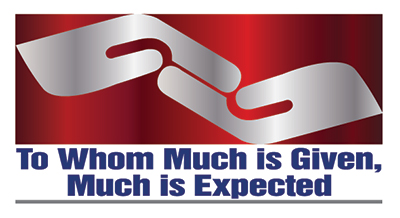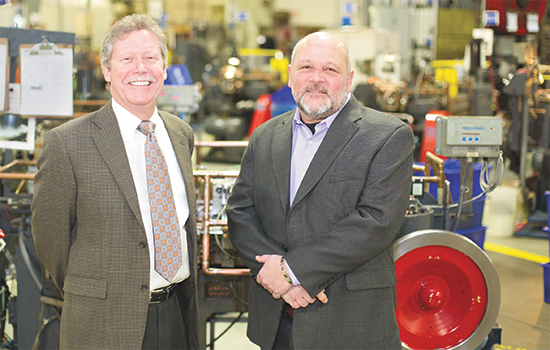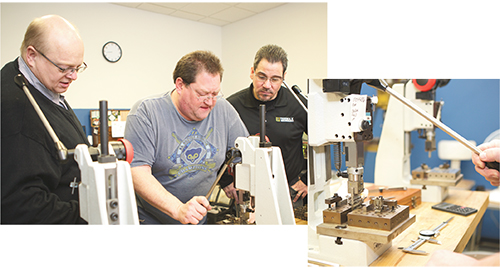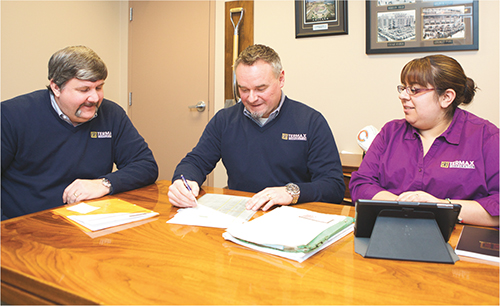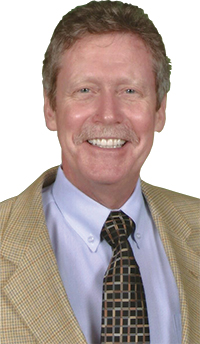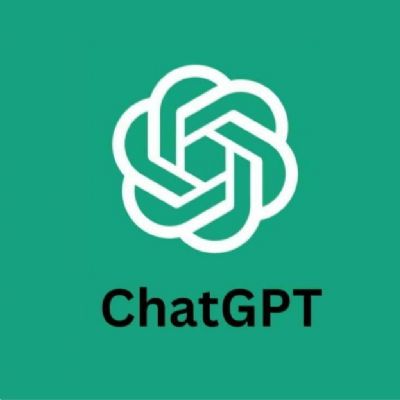Streamlined and Simplified
Southwest Airlines co-founder and former CEO Herb Kelleher employed—and perfected—a simplified and streamlined business plan, and Smith emulated it when he developed his business plan for Termax. The gist of the Southwest plan, elegantly captured in a 2008 Washington Post article: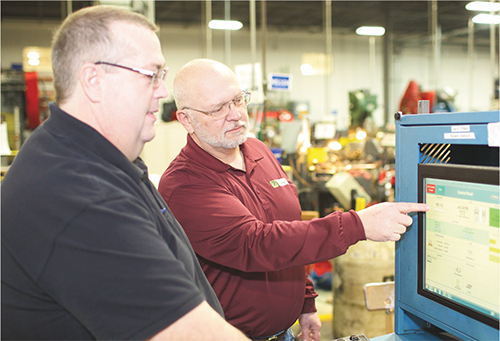
Termax director of operations Ken Bird (right) and IT manager Mike Ossi review production operations at one of several Plex ERP terminals on the plant floor.
“What does Southwest have that no one else in airlines does? It keeps things simple and consistent, which drives costs down, maximizes productive assets, and helps manage customer expectations.”
At Termax, that ideal has translated into a tight focus on slideforming and punch pressing of steel fasteners and “limiting ourselves to one particular type of machine,” says Smith, “a #28 (28-ton) U.S. Baird, and small presses. My dad had two small Bairds, and now we have more than 60 of the machines. We sought to standardize, as did Southwest (which standardized on one type of airplane), simplify and streamline. We worked hard to limit what we did, and be the best at it.” Termax now also employs a sophisticated injection-molding operation, along with overmolding and assembly, using the same fasteners with a value-added component.
Smith further emphasizes that a business can only succeed, regardless of the plan in place, when its employees feel committed and devoted to that success.
The 3M Way to Innovation: Balancing People and Profit
The third and final leg to Smith’s business plan for Termax rounded into shape when he studied closely the story of Minnesota Mining & Manufacturing (3M).
“3M has a tolerance for tinkerers,” one company executive wrote, “and a pattern of experimentation.”Another executive wrote:
“3M’s success was built on unique products—products that were protected by patents.”
At Termax we find a similar devotion to innovation. “3M sought to have at least 70 percent of everything it manufactured having been invented by its employees,” Smith says. “That’s been our goal as well, and we’ve surpassed it. By asking our employees to ‘think like engineers’ and to focus on creativity and innovation, 75 percent of everything we manufacture is proprietary—products that no other company sells to the market.”
Smith also emulates one other attribute of 3M’s leadership: a perfect segue to his theme of giving back to the industry. Consider this quote attributed to Kay Grenz, former vice president of human resources at 3M, from the book “A Century of Innovation: The 3M Story:”
“Mentoring is an established part of the fabric of 3M and one of the key reasons why the culture has been sustained for so long.”
Core Beliefs
Smith names several prominent, savvy and smart PMA executives who showed him the ropes and took him under their wings when he became involved with the association. He’s committed, as part of his aim to give back, to develop a formal way to offer those same opportunities to others in the industry looking for guidance. Hence the formal mentoring program on his PMA wish list.
Similarly, Smith believes strongly that he and his company, PMA and the metalforming industry in general should direct some of the industry’s recently earned profits to help support the next generation of metalforming companies. The ideal vehicle for such an investment: The PMA Educational Foundation (PMAEF).
“Next year marks PMAEF’s 20th anniversary,” says Smith. “Since 1996, it has been helping to develop a trained and motivated metalforming-industry workforce. Through its programs and funding, national skill standards have been developed for skilled metalforming jobs; performance measures and written tests have been developed to support a national credentialing system; and curriculum and training materials have been developed that allow companies to train their employees at various levels.
“None of this could have been possible without the generosity of several companies and individuals who contributed more than $2 million to the PMAEF Endowment Fund,” Smith continues. “Now I’d like to see another round of contributions, to ensure that the next generation of metalforming companies has the support it needs.”
As evidence of the positive impact PMAEF programs can have on the industry, Smith describes the foundation’s latest project—the ECHO (employee, contractor and hospitality orientation) Onboarding Program. Once completed, the self-administered competency-based program will use a multimedia approach (PowerPoints, videos, etc.) to support companies as they initiate new employees into the fold. Topics included in the orientation: personal-protective equipment, workplace behaviors, career opportunities, and health and wellness.
An Advocate for Advocacy
The third core belief anchoring Smith’s theme centers on advocating at the government level on behalf of manufacturing.
“We’ve been given so much,” he says, “and I feel that a great way to give back is to continue to make our voice louder and stronger in Washington, D.C., and with our local government officials.”
Since 2004, Smith has participated in PMA’s annual visits to Capitol Hill to meet with congressmen—a core undertaking of the PMA/NTMA One Voice combined federal-government advocacy program. The One Voice joint advocacy program, which represents small and medium-sized manufacturers, gives a voice to the millions of middle-market manufacturing companies and employees who supply tooling, components and other manufactured products.
Smith invites more metalforming companies—and manufacturers in general—to “grow the collective herd and raise our voice even more,” he says. He attended his first fly-in with PMA to Washington, D.C. in 2004, and hasn’t missed one since. Since 2008, fly-ins and visits to Capitol Hill have been conducted in conjunction with the NTMA/PMA One Voice Legislative Conference.
So committed to the cause is Smith that each year he leads a group of like-minded manufacturing executives up to Capitol Hill to facilitate meetings with members of Congress and their staffs. He has been at the forefront of tax-policy discussions, having met with the Senate Finance Committee, House Ways & Means Committee and the Office of the Speaker—calling for comprehensive tax reform. And, in November 2011, Smith testified before the House Small Business Committee’s Subcommittee on Economic Growth, Tax and Capital Access.
“Our activity on Capitol Hill has proven so incredibly valuable and has made a palpable difference,” Smith says. “Along with my counterparts from PMA and NTMA, we have had numerous in-depth conversations with congressmen from all over the country to raise their awareness of our concerns, and key issue perspectives.”(Editor’s note: The 7th Annual NTMA/PMA One Voice Legislative Conference is scheduled for April 21-22, 2015; learn more at www.metalworkingadvocate.org.)
PMA Offers Company-Wide Support
Smith has gained personal and professional enrichment from engaging with PMA. Beyond that, Termax has experienced growth and prosperity in large part fueled by encouraging others throughout the company to take advantage of PMA’s various opportunities to learn and network. Examples abound:
• Human-resources director Maria Rivas is an active participant on the PMA human-resources listserve; attends its annual roundtable event; participates in the Women in Manufacturing organization; and attended the PMA Management Development Academy (MDA).
• Logistics director (and former purchasing manager) Tom Boss participates in the PMA safety committee, and attended the MDA.
• Company president Wes Gardocki belongs to one of PMA’s executive-networking groups, and attended the (new for 2015) PMA Executive Development Academy (EDA).
• Toolroom manager Rick Ducato attends local Chicago-District PMA meetings, and also attended the MDA.
• IT manager Mike Ossi participates in PMA’s IT roundtable.
• CFO John Hoeksema attends the annual CFO Roundtable meeting.
“Roundtable meetings, in particular, have proven time and again to be extremely valuable learning opportunities for many on our management team, myself included,” Smith says. “These peer-group meetings often create mentoring opportunities, and our managers always come back from the meetings with ideas we can implement here at Termax.”
Asked to provide an example, Smith points out the most recent PMA networking event he attended—the EDA program, held January 7-9, 2015, in Tampa, FL. The event featured speakers from J.P. Morgan, Foley & Lardner, Plante Moran and other organizations.
“Nearly 40 metalforming-industry executives attended,” he says, “to network with peers and learn from speakers on topics such as generational differences, content marketing and social media, international business and leadership excellence.
“These types of networking and idea-sharing initiatives prove that you don’t have to be a brain surgeon to succeed in manufacturing. There are plenty of opportunities, through PMA, to learn from others, and to share what you have learned.” MF
View Glossary of Metalforming Terms
Technologies: Management






